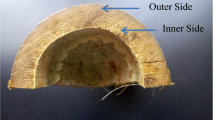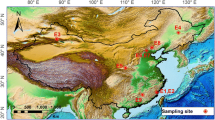Abstract
Sorghum of the family Poaceae is one of the important cereal crops of India which accumulate silica in the form of phytoliths. Silica which forms phytoliths has manifold role in the crop plants. It enhances the crop quality, yield, growth and protects the plant from various biotic and abiotic hurdles. Present paper provides brief observations of the morphology, diversity and frequency of opal phytoliths in leaves of Sorghum bicolor and Sorghum halepense. Among all the morphotypes, bilobate phytoliths showed the highest frequency in both species while other forms like trapezoids, prickle hair, micro hair, long micro hair, epidermal long cells, stomata, bulliform and parallelepipedal phytoliths are present in minimal range. Some phytoliths like micro hair and polylobate phytoliths are not present in S. bicolor while they are present in S. halepense. The frequency of all the phytoliths of both the species is remarkably varied whereas the morphometry of these phytoliths is slightly varied. Therefore, these results could contribute in evaluating their taxonomic demarcation as well as will help to investigate their history of cultivation.





Similar content being viewed by others
References
Epstein E (2009) Silicon: its manifold roles in plants. Ann Appl Biol 155:155–160
Tripathi DK, Singh VP, Kumar D, Chauhan DK (2012) Impact of exogenous silicon addition on chromium uptake, growth, mineral elements, oxidative stress, antioxidant capacity, and leaf and root structures in rice seedlings exposed to hexavalent chromium. Acta Physiol Plantarum 34:279–289
Jones LHP, Handreck KA (1967) Silica in soils, plants, and animals. Adv Agron 19:107–149
Tripathi DK, Singh VP, Kumar D, Chauhan DK (2012) Rice seedlings under cadmium stress: effect of silicon on growth, cadmium uptake, oxidative stress, antioxidant capacity, and root and leaf structures. Chem Ecol 28(3):281–291
Chauhan DK, Tripathi DK, Rai NK, Rai AK (2011) Detection of Biogenic Silica in Leaf Blade, Leaf Sheath, and Stem of Bermuda Grass (Cynodon dactylon) Using LIBS and Phytolith Analysis. Food Biophys 6:416–423
Piperno DR (2006) Phytoliths: a comprehensive guide for archaeologists and paleoecologists. Rowman Altamira Press, New York
Chauhan DK, Tripathi DK, Kumar D, Kumar Y (2011) Diversity, distribution and frequency based attributes of phytolith in Arundo donax L. Int J Innov Biol Chem Sci 1:22–27
Metcalfe CR (1960) Anatomy of the monocotyledons I. Oxford University Press, London
Twiss PC, Suess E, Smith RM (1969) Morphological classification of grass phytoliths. Soil Sci Soc Am Proc 33:109–115
Mercader J, Astudillo F, Barkworth M, Bennett T, Esselmont C, Kinyanjui R, Grossman DL, Simpson S, Walde D (2010) Poaceae phytoliths from the Niassa Rift, Mozambique. J Archaeol Sci 37:1953–1967
Lu HY, Liu KB (2003) Morphological variations of lobate phytoliths from grasses in China and the south-eastern United States. Divers Distrib 9:73–87
Krishnan S, Samson NP, Ravichandran P, Narasimhan D, Dayanandan P (2000) Phytoliths of Indian grasses and their potential use in identification. Bot J Linn Soc 132:241–252
Thorn VC (2006) Vegetation reconstruction from soil phytoliths Tongariro National Park, New Zealand. N Z J Botany 44:397–413
Carnelli AL, Theurillat J, Madella M (2004) Phytolith types and type-frequencies in subalpine-alpine plant species of the European Alps. Rev Palaeobot Palynol 129:39–65
Pearsall D, Piperno D, Dinan EH, Umlauf M, Zhao Z, Benfer RA (1995) Distinguishing rice (Oryza sativa, Poaceae) from wild Oryza species through phytolith analysis: results of preliminary research. Econ Bot 49:183–196
Iriarte J, Holst I, Marozzi O, Listopad C, Alonso E, Rinderknecht A, Montana J (2004) Evidence of cultivar adoption and emerging complexity during the mid-Holocene in La Plata basin, Uruguay. Nature 432:614–617
Gallego L, Distel RA (2004) Phytolith assemblages in grasses native to Central Argentina. Ann Bot 94:865–874
Fernández Honaine M, Bernava Laborde V, Zucol A (2005) Silica content in native grasses from SE Buenos Aires province Argentina. Phytolitharien 17(2):20–21
Hodson MJ, Sangster AG (1989) X ray micro analysis of seminal root of Sorghum bicolor (L) Moench with particular reference to Silicon. Ann Bot 64:659–667
De Silva D, Hillis WE (1989) The contribution of silica to the resistance of wood to marine borers. Holzforschung 34:95–97
Hanifa AM, Subramaniam TR, Ponnaiya BWX (1974) Role of silica in resistance to the leaf roller, Cnaphalocrocis medinalis Guenee, in rice. Indian J Exp Biol 12:463–465
Kunoh H, Ishizaki H (1975) Silicon levels near penetration sites of fungi on wheat, barley, cucumber, and morning glory leaves. Physiol Plant Pathol 5:283–287
Blecker S, King S, Derry L, Chadwick O, Ippolito J, Kelly E (2007) The ratio of germanium to silicon in plant phytoliths: quantification of biological discrimination under controlled experimental conditions. Biogeochem 86:189–199
Elbaum R, Melamed-Bessudo C, Tuross N, Levy AA, Weiner S (2009) New methods to isolate organic materials from silicified phytoliths reveal fragmented glycoproteins but no DNA. Quat Int 193:11–19
Fraysse F, Pokrovsky OS, Schott J, Meunier J (2009) Surface chemistry and reactivity of plant phytoliths in aqueous solutions. Chem Geol 258:197–206
Madella M, Jones MK, Echlin P, Powers-Jones A, Moore M (2009) Plant water availability and analytical microscopy of phytoliths: implications for ancient irrigation in arid zones. Quat Int 193:32–40
Rovner I (1983) Plant opal phytoliths analysis: major advances in archaeobotanical research. In: Schiffer M (ed) Advances in archaeological methods and theory, vol 6. Academic Press, New York
Twiss PC (1987) Grasses-opal phytoliths as climatic indicators of the great plains pleistocene. In: Johnson WC (ed) Quaternary environments of kansas, vol 5. Geological Survey Guidebook, Lawrence, pp 179–188
Lux A, Luxovai M, Jun Abe, Tanimoto E, Taiichiro H, Shinobu I (2003) The dynamics of silicon deposition in the Sorghum root endodermis. New Phytol 158:437–441
Hattori T, Sonobe K, Araki H, Inanaga S, An P, Morita S (2008) Silicon application by Sorghum through the alleviation of stress-induced increase in hydraulic resistance. J Plant Nutr 31:1482–1495
Ahmed M, Hassen F, Qadeer U, Aslam MA (2011) Silicon application and drought tolerance mechanism of Sorghum. African J Agric Res 6:594–607
Stebbins GL (1938) A bleaching and clearing method for plant tissues. Science 87:21–22
Fahmy AG (2008) Diversity of lobate phytoliths in grass leaves from the Sahel region, West Tropical Africa: tribe Paniceae. Plant Syst Evol 270:1–23
Ma JF (2010) Silicon transporters in higher plants. Adv Exp Med Biol 679:99–109
Tubb JH, Hodson JM, Hodson CG (1993) The inflorescence papillae of the Triticeae: a new tool for taxonomic and archaeological research. Ann Bot 72:537–545
Portillo M, Ball T, Manwaring J (2005) Morphometric analysis of inflorescence phytoliths produced by Avena sativa L. and Avena strigosa Schreb. Econ Bot 60:121–127
Rosen AM (1992) Preliminary identification of silica skeletons from Near Eastern archaeological sites: an anatomical approach. In: Rapp GR, Mulholland SC (eds) Phytolith systematics. Plenum Press, New York, pp 129–147
Zhao Z, Pearsall RA, Jr Benfer, Piperno D (1997) Distinguishing rice (Oryza sativa, Poaceae) from wild Oryza species through phytolith analysis: results of preliminary research. Econ Bot 52:134–145
Houyouan L, Naiqin W, Baozhu L (1997) Recognition of rice phytoliths. In: Pinilla A, Juan-Tressaras J, Machado MJ (eds) The state of the art of phytoliths in soils and plants. Madrid, pp 159–174
Piperno DR, Flannery KV (2001) The earliest archaeological maize (Zea mays L.) from highland Mexico: new accelerator mass spectrometry dates and their implications. Proc Natl Acad USA 98:2101–2103
Rovner I (1971) Potential of opal phytolith for use in paleoecological reconstruction. Quat Res 1:343–359
Acknowledgments
The authors are thankful to Head of the Botany Department University of Allahabad, Allahabad, India for providing the necessary research facilities. D. K. Tripathi is grateful to the Allahabad University for providing D.Phil. Fellowship under the UGC scheme.
Author information
Authors and Affiliations
Corresponding author
Rights and permissions
About this article
Cite this article
Tripathi, D.K., Mishra, S., Chauhan, D.K. et al. Typological and Frequency Based Study of Opaline Silica (Phytolith) Deposition in Two Common Indian Sorghum L. Species. Proc. Natl. Acad. Sci., India, Sect. B Biol. Sci. 83, 97–104 (2013). https://doi.org/10.1007/s40011-012-0066-5
Received:
Revised:
Accepted:
Published:
Issue Date:
DOI: https://doi.org/10.1007/s40011-012-0066-5




